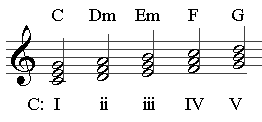
[ How to construct ] [ How to recognize ]
A chord symbol is formed with two parts: the first letter (with possible modification of "b" or "#" after) indicating the root of the chord, with the quality of the chord coming after. We have seen five different qualities for triads--major, minor, augmented, diminished, and suspended.

The triads above are built on the first five notes of the C major scale. The root of the C major chord is the note "C", the root of the D minor chord the note "D", and so on.
A major chord is symbolized with a capital letter, in the case above, "C", "F", and "G" are major triads. Minor chords add a "m" after the root of the chord, augmented triads add a " ° ", augmented chords a " + ", and suspended chords a "sus".
Chords with the root of the chord on the bottom are said to be in "root" position. However, as long as you have the notes "C", "E", and "G" played simultaneously you have a C major chord. With three notes you have three different possible arrangements. The notes do not always have to be played grouped tightly together with the root of the chord on the bottom. One way to change the sound is to invert the chord, by putting other notes than the root on the bottom. Below we see the C major again in root position, followed by first and second inversion.
Starting from the root position (C-E-G), you can move to first inversion by holding the top two notes where they are (the E and G) and moving the root of the chord (C) up to the top note. The third of the chord (E) is now on the bottom.
To then change to second inversion you follow the same process: hold the top two notes where they are (the G and C) and move the bottom note of the chord (E) up to the top. The fifth of the chord (G) is now on the bottom.
This table shows how the degrees of the scale are ordered in the three positions:
| root | 1st inversion | 2nd inversion |
| 3 | ||
| 1 | 1 | |
| 5 | 5 | 5 |
| 3 | 3 | |
| 1 |
![]()
As usual, the best place to work this out is at the keyboard. Play a triad in root position, say the name of the chord and its position (i.e. "C major, root position"), then hold the top two notes and move the bottom note up an octave. Speak the chord and position again ("C major, first inversion"). Go to second inversion by holding the top two notes and moving the bottom note up an octave ("C major, 2nd inversion"). Go up once again by holding the top two notes and moving the bottom note up an octave and you're back to root position ("C major, root position").
You will have to do some switching of fingers to accommodate this. I suggest that you hold the keys down while you're thinking of where you are going next so that you continue to hear the sound and don't get lost with your fingers in the air. Generally the best fingering for root position in the right hand is 1-3-5, the best for first inversion 1-2-5, and second inversion 1-3-5.
For the left hand it's just the opposite: root position is 5-3-1, first inversion 5-3-1, and second inversion 5-2-1.
You can quickly tell when a chord is written in root position because all the notes are either on lines or spaces:

If you see notes written on the staff and want to know what the chord is, the first step is to make sure the chord is in root position. The triad below is, so we know that it is going to be a D chord of some kind. Next we have to determine the quality.
If it is, the next step is to compare it with something you know. If you are working on a triad, compare it with a major triad (1-3-5 of the major scale), and see if anything has been altered:
On the left we construct a D major triad using the 1st, 3rd, and 5th notes of the D major scale. If you aren't sure what notes have sharp or flat signs preceding them, then stack three note heads on top of a "D", then recall from the Circle of Fifths that D major has two sharps (F# and C#) and see if any of the three notes you've drawn are "F" or "C". There isn't "C" in the D major triad, but there is an "F", so we put a sharp before it. To the right of the D major chord we've made is the chord in question. We see that the 3rd and 5th have been lowered from the D major chord. We recall from our chord formulae that 1,-3,-5 is diminished, so therefore the chord we're working on is D°.
![]()
©2001 Robert Willey